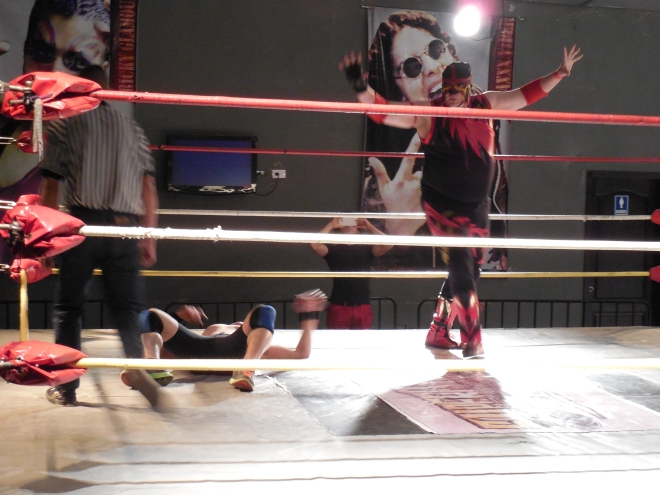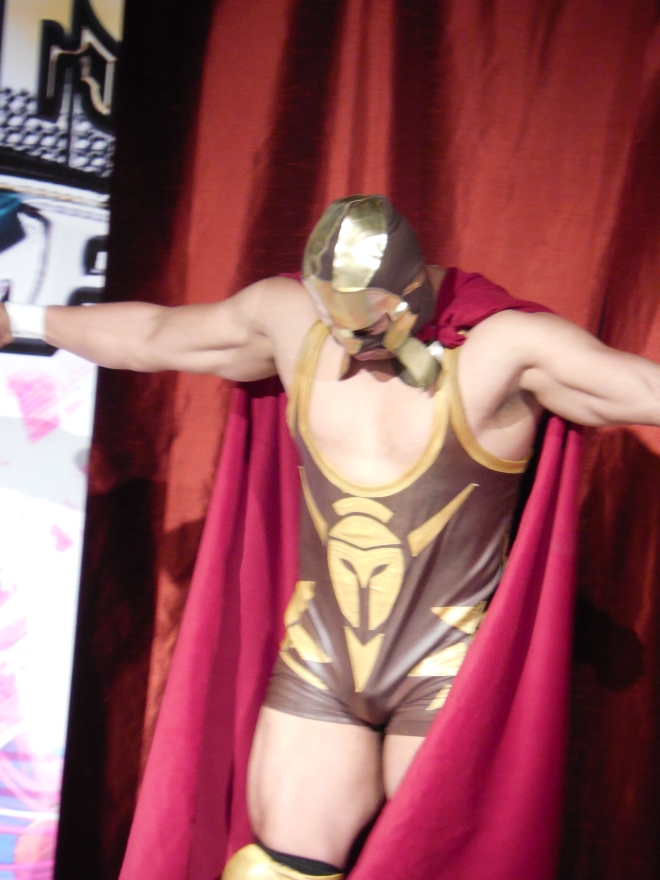
Lucha libre action in the ring. Photo © Lorraine Caputo
While waiting for tonight’s event to begin, people line up at the small stand to buy sodas and the ubiquitous Ecuadorian snack of salchipapas (hot dogs and French fries) to share amongst the entire family. The stands around two sides of the small arena fill. The spectators watch films of past matches on the big screen TVs. In the middle is the ring where tonight’s action will take place. Spotlights already bathe it. Large posters of the star wrestlers – Big Venom, Minister, Dr. Pesadilla, Ricky Glamour, Maxxx Viper – decorate the walls.
As the time nears for the event, hands slightly part the red curtain at the far end of the room. The spectators begin to clap, to stomp, to whistle. But it is only a tease. Soon enough, though, the two announcers take their seats at the table to the right of that slit in the red curtains. The referee climbs into the ring. And the action begins.

El Gladiador makes his entrance. Photo ©Lorraine Caputo
In the first half, El Gladiador is abandoned by his evil teammates. He swears he will turn to the Light. This raises a round of cheer from his multitudes of fans. The first match of the second half features Ricky Glamour, one of the most popular wrestlers of Ecuador’s lucha libre. The night ends with a free-for-all, break-loose match between many of the fighters. It spills out of the ring, one large hulk chasing another and another round the arena, into the stands.
The night is over. Families depart into the cool mountain evening. Plastic cups and bowls with caking ketchup and mayonnaise skitter across the emptying parking lot.

The night ends with mayhem spilling out of the ring, right at our feet. Photo © Lorraine Caputo
History of Professional Wrestling in Ecuador
In Latin America, professional wrestling is called lucha libre. Mexico is renowned for its long history of this sport. Its most famous stars came to Ecuador. The saint of all kids like El Gladiador was El Santo. Some thirty years ago, Argentina also made the scene with stars like Martín Karadagián and La Momia. Influenced by these two countries, professional wrestling arrived in Ecuador in the 1970s.
Today, four wrestling federations operate in Ecuador, based in Quito and Guayaquil. In the capital, the season is year round. In the coastal metropolis of Guayaquil, there are no matches during the first four months of the year, due to the rainy season.
One of the major federations is WAR (Wrestling Alliance Revolution). Its shows feature the lucha entre los Buenos y los Malos – the struggle between Good and Evil. Its stable of fighters travel to other cities and small villages to do events.
In real life, these fighters, who range in age from 16 to 40, are hostel managers, English teachers, journalists, dog breeders and gym owners. Most are fathers. But this sport isn’t just limited to males. Women are also professional wrestlers, and mixed matches are held the same night as the main events.
WAR’s live events may be caught at the arena at Río Vuano y Av. de La Prensa in north Quito (Metrobus stop La Florida). Tickets ($5) go on sale at 5 p.m. the day of events. Fights begin at 6 p.m. If you can’t make it to the matches, you can watch them on WAR’s you tube channel.

El Gladiador at rest, thinking of future conquests. Photo © Lorraine Caputo
One early summer day in Quito, I sat down with one of the stars of WAR, El Gladiador. Weighing in at 215 pounds, this 37-year-old fighter is one of the most popular of WAR’s fighters, especially among children who consider him a hero. El Gladiador even has his own channel on you tube. He started his career as a Malo, but now he has joined the ranks of the Buenos.
Before becoming a professional wrestler five years ago, El Gladiador was a successful bodybuilder in the 80 kilogram (190 pound) class. He was Mr. Pinchincha in 2002, and placed third in Mr. Quito 2002. He also practices muay tai, jujitsu, mixed martial arts. As a wrestler, he was the Champion in Parejas (Tag Team) a few year years back.
Why did you decide to become a wrestler?
I have liked lucha libre since I was a child. I watched it on TV and the WWF. I would stop whatever I was doing to watch lucha libre. Also I liked Arnold Schwartzenegger’s movies and Hercules.
Who were your inspirations, your favorite fighters?
The Argentinians, the Titanes en el Ring. Hulk Hogan, the Ultimate Warrior – both of the US – were also huge, strong. Of today’s fighters: the Rock and Kane. Especially the Rock.
I have seen photos of you as a bodybuilder. You looked much leaner, much more sinewy than as a wrestler.
In bodybuilding, you work for less body fat and water – to give muscles more definition. In wrestling, these are necessary in order to protect yourself from the blows and falls.
I always thought of professional wrestling as a show, as theater – all fake. But when I went to the matches to see you fight, I came to realize that it takes a lot of training to learn how to fall correctly, and to throw punches that won’t injure your opponent. What is training like?
Wrestling is a high-risk sport. Injuries can easily end a career or lead to death. Unlike the U.S., we don’t have to report our hands as deadly weapons.
Not all is drama in lucha libre. Many come to the sport, but leave after the first training session.
We have to learn techniques to fall, to receive blows. The chest and back have to be able to resist more. Also to hit without causing injury. I work out two to three times per week, two to three hours each time. It includes weightlifting, jogging and cardio-vascular exercises.
Before entering the ring, a fighter trains for eight months to a year. In a new fighter’s first time in the ring, the older wrestlers gives the newcomer a ceremony, a baptism of blows and machetazos (chops): five blows to the upper chest.
And what type of diet and lifestyle do you have to follow?
No smoking, no drinking, no drugs. We eat a lot of animal protein.
And any restrictions about sex coming up to a fight? My father was a professional boxer, and he often mentioned that.
El Gladiador laughs. No, no restrictions on sex, he responds.
Of the Buenos and the Malos, it surprised me that one of the most popular fighters is Ricky Glamour, whose personage is a stereotypical gay and a good guy. How can you explain this in a country where homosexuality is looked down upon?
He’s an “exotic fighter.” In Ecuador, homosexual jokes are popular between men. It’s the sal quiteña: we are jokers, happy.

Ricky Glamour makes his grand entrance with much glamp and golden glitter. Photo © Lorraine Caputo
El Gladiador had a relative who was a professional wrestler about 40 years ago. In that age, they went to the small towns and fought in rustic rings that were made of oil barrels with a board atop, covered only with a rug. It was really high risk.
A friend of El Gladiador – who only wishes to be identified as “El Negro” – joins our conversation. El Negro is of Chillo-Jijón and Amaguaña indigenous descent. His long straight hair is tied back in a ponytail and his chin capped with a salt-and-pepper goatee. With his stocky build, he looks like he could be a professional wrestler as well.
El Negro grew up in Chimbacalle, one of the poor neighborhoods on the south side of the capital. He has been an aficionado of professional wrestling since he was a kid. I ask him whether he ever wanted to be a professional wrestler like his friend, El Gladiador.
“When I was a guambra (kid), I loved wrestling. But you know how parents are: How are you going to earn a living? Lucha libre was considered ridiculous. I was a student of sports, and later was a soccer and basketball trainer.” He is now, by trade, a jewelry maker
“Some 35 years ago, the basketball courts at Chimbacalle was where the matches took place. It was open-air, a boxing ring. The big wrestlers at that time were Monje Loco and Fortunato y Hermoso. Tickets were only three sucres. Kids would save their money for school snacks to go. And before, the matches were only during vacations. Now they’re all year round.”
“Before Chimbacalle, according to my father, the fights took place at Plaza Arenas.”
There’s a mercado called Plaza Arenas tucked between La Guaragua (Calle Galápagos) and Calle Venezuela, near the Básilica in Quito’s Centro Histórico. I interject, “In the market there?”
“No. Before it was the market we know today, it was a Plaza de Toros (bullfighting ring). After Chimbacalle, fights took place at the Coliseo Julio César Hidalgo in La Marín.”

The empty ring awaits it fighters. ¡Lucha libre! Photo © Lorraine Caputo
Ecuador’s Lucha Libre in Film
Just a few weeks ago, a new film featuring El Gladiador and other Ecuadorian wrestlers hit the silver screens in Quito. It’s called La Rompecuellos. But this isn’t the first film about professional wrestling in Ecuador.
Santo y Evaristo contra los Secuestradores (Federico Curiel, 1972) was a Mexican-Ecuadorian production starring Mexican legends El Santo and Ernesto Albán “Evaristo.” In this production, Interpol’s Special Investigations unit sends Santo to Ecuador to investigate a kidnapping and counterfeiters.
Three decades later, Ecuadorian director and writer Vivian Codero presented Un Titán en el Ring (2002). In this story, a new priest arrives to a small village deep in the Andes mountains where wrestling matches are the main entertainment for the children and town folk. When a corrupt promoter comes to town, the villagers rise up.
In the same year, Lucha libre – Historia del luchador la Sombra de Ecuador (2002) was released. This mini-documentary recounts the career of La Sombra, an Ecuadorian wrestler who gained international fame.
Lucha Libre in Latin America
Where else in Latin America can you catch the action of professional wrestling?
The country with the longest history, most influence and strongest contemporary following is Mexico. The heroes are often found in real life outside the ring, fighting the ills of modern Mexican society and corruption. Matches are held in Mexico City, Puebla, Guadalajara and other major cities. Mexico has been the example for lucha libre for much of the rest of Latin America.
Argentina also has had a vibrant lucha libre scene. El Gladiador cites la Momia and the Titanes en el Ring as some of his childhood favorites. He and El Negro reminisced of the classic Titanes fight, of la Momia versus Martín Karadagián.
Bolivia has a strong women’s league of this sport, dominated by the Fighting Cholitas – indigenous women dressed in their traditional garb of multi-layered polleras (skirts) and petticoats. You may catch their matches in El Alto, city perched on the altiplano above La Paz. A 2006 documentary, The Fighting Cholitas, won an honorable mention in the Short Filmmaking category at the Sundance Film Festival.


















